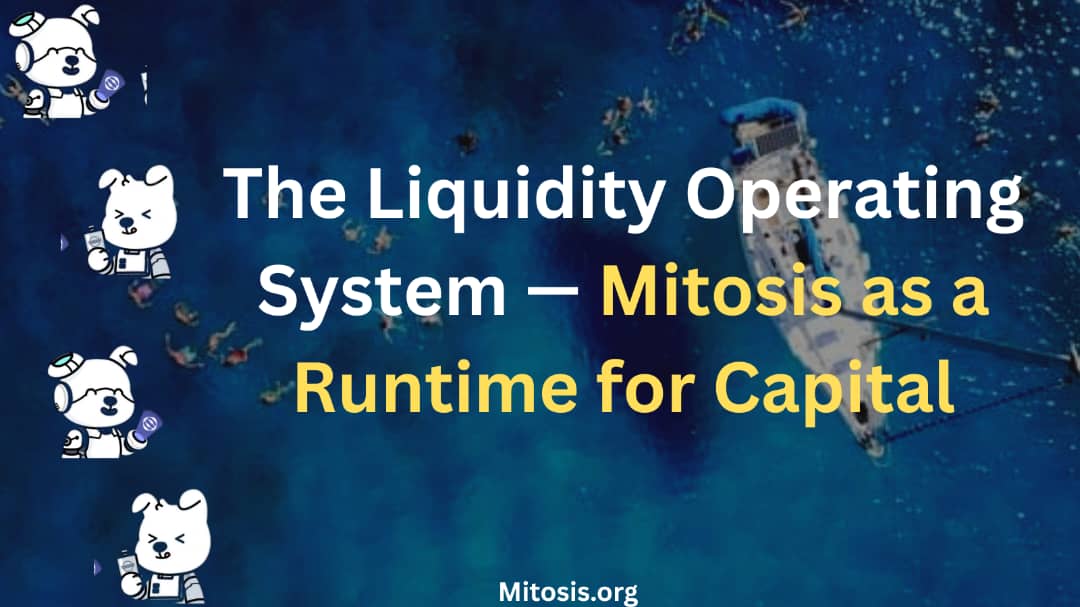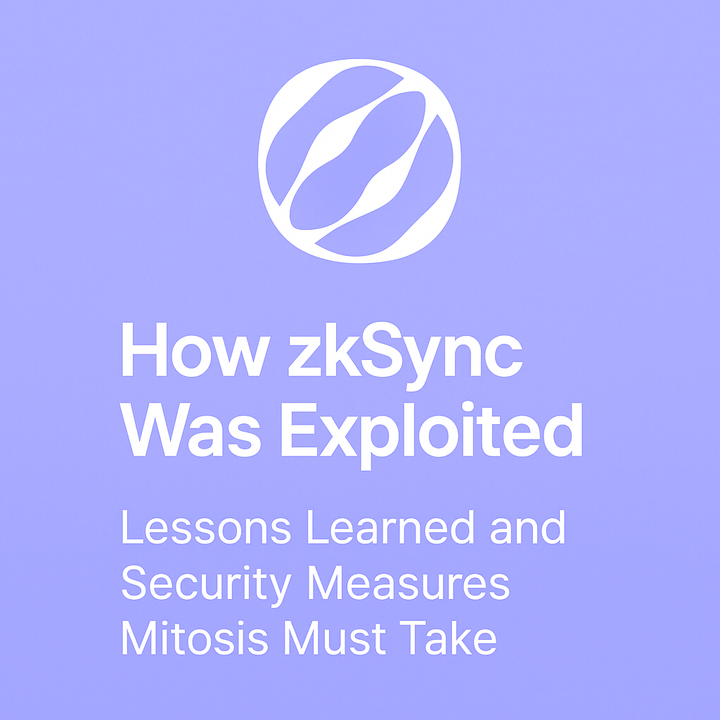The Liquidity Operating System: Mitosis as a Runtime for Capital

In the evolving architecture of DeFi, infrastructure is moving beyond chains and protocols. What’s emerging is something more abstract, more powerful, a liquidity operating system, a layer that can direct, reallocate, and optimize capital across fragmented ecosystems without asking users to care about which chain they’re on or where the yield is.
Mitosis isn't just a vault protocol. It's becoming the liquidity runtime, an OS where capital runs, learns, and grows.
1.0. Capital Needs a Runtime
In traditional computing, an operating system (OS) is the bridge between hardware and application logic. It abstracts away complexity, manages memory, handles communication between processes, and provides a standardized environment where programs can run predictably.
In DeFi, capital has lacked this runtime. Each chain is its own island. Each protocol, its own logic. Each LP position, siloed, non-transferable, and reactive. But capital isn’t static anymore, it moves, it chases yield, it seeks efficiency. It needs an intelligent execution environment.
That’s where Mitosis steps in.
Mitosis abstracts away chain-specific infrastructure and vault-by-vault management and presents a unified operating layer where capital can be deployed, rebalanced, and composably extended all without needing to manually interact with each protocol.
2.0. Building Blocks of the Mitosis OS
Let’s unpack what this liquidity operating system really looks like.
- Matrix Vaults = Liquidity Containers
Matrix Vaults function like memory blocks or processing units in a traditional OS. They hold capital but aren't passive—they can execute rebalancing logic, optimize strategies, and route liquidity cross-chain in real time.
They’re programmable, composable, and operate under shared economic rules.
- Interchain Execution = Native Cross-Chain Support
Mitosis is chain-agnostic. Through Hyperlane integration and permissionless messaging, it achieves interchain composability—the equivalent of an OS being able to run programs across different hardware platforms.
In practice, this means a single Mitosis vault can move capital across Ethereum, Arbitrum, Optimism, and more—based on where it's most needed.
- maAssets = Tokenized Access to Memory Blocks
maAssets are tokenized representations of vault shares, like handles to memory in an OS. These assets abstract away the complexity of vault architecture and enable plug-and-play composability, allowing other protocols to use Mitosis assets as primitives for lending, borrowing, or derivatives.
This creates a standardized interface layer for liquidity.
3.0. Protocols as Applications
With Mitosis, protocols don’t need to worry about building their own yield infra or cross-chain strategies.
They can plug into Mitosis as developers plug into an operating system abstracting away complexity, saving resources, and focusing on product logic.
For example:
- A lending protocol can route idle stablecoin liquidity into Mitosis vaults with risk caps.
- A DEX can dynamically adjust its incentives based on real-time TVL and APY data fed from Mitosis.
- A treasury DAO can deploy capital once, and let Mitosis handle multi-chain yield strategy behind the scenes.
This creates a standardized developer experience for DeFi primitives—vaults, liquidity, and yield become APIs, not headaches.
4.0. Composability as a System Call
In an OS, system calls allow apps to request services from the core kernel like file storage or network access. In Mitosis, composability is the system call.
Any protocol or vault can:
- Request liquidity rebalancing
- Trigger a cross-chain bridge operation
- Subscribe to TVL or APY metrics
- Mint/redeem maAssets or miAssets
- Delegate capital across strategies
These actions are programmatically accessible, enabling DeFi projects to build more advanced capital logic on top of Mitosis.
5.0. A Unified Capital Logic Layer
With the rise of appchains, rollups, and sovereign L2s, fragmentation is inevitable. But fragmentation of liquidity logic doesn’t have to be.
Mitosis offers:
- A single control plane for liquidity strategy
- Real-time visibility across all vaults and chains
- Policy tooling for DAO governance and allocation
- Modular plug-ins for automated strategies
This moves us toward a future where yield strategy is no longer protocol-specific. It’s global. Shared. Governed.
Mitosis becomes the runtime layer where all capital flows are visible, steerable, and interoperable.
6.0. DeFi Needs Invisible Infrastructure
End users shouldn’t know what vault they’re in, what chain their funds sit on, or what bridge was used. They should only care about:
- Is my capital working efficiently?
- Can I access my funds anytime?
- Am I protected from risk?
The ideal liquidity OS abstracts these answers with intelligent defaults, automated risk routing, and fully interoperable vault logic.
Mitosis is building that OS layer. Invisible to the user, powerful for the builder.
7.0. Capital as Code, Vaults as Infrastructure
The Mitosis vision is clear: treat capital like code—deployable, testable, upgradable. Treat vaults like infrastructure—shared, permissionless, optimized.
Protocols should no longer compete to build their own vaults. Instead, they should coalesce around a shared liquidity runtime where:
- Liquidity is modular and re-usable.
- Capital is programmable and adaptive.
- Yield is composable, not siloed.
Conclusion: The Future of DeFi Runs on Mitosis
DeFi doesn’t need more complexity, it needs composability. It doesn’t need more bridges, it needs a system that makes bridges invisible. It doesn’t need more vaults, it needs a layer that orchestrates vaults as a symphony across chains.
That’s what Mitosis offers.
By functioning as the liquidity operating system, Mitosis introduces an entirely new design space for DeFi:
- Capital becomes mobile, modular, and intelligent.
- Builders gain a plug-and-play runtime for deploying advanced strategies.
- Users benefit from optimized yield with zero overhead or chain-specific knowledge.
We’re witnessing the transformation of DeFi infrastructure from siloed and reactive to unified and programmatic. Mitosis isn’t just participating in that shift, it’s defining the standard.
Just like modern applications no longer think in terms of hardware, DeFi protocols will stop thinking in terms of individual chains or vaults. They'll simply deploy liquidity logic and Mitosis will run it.
The future of capital is code. And Mitosis is the runtime that makes it all possible.
Are you ready to be part Mitosis Community?



Comments ()